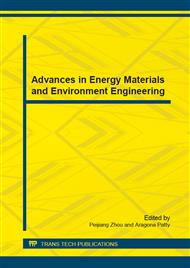p.344
p.350
p.360
p.364
p.368
p.374
p.386
p.390
p.394
Vertical Distribution and Pollution Assessment of Heavy Metals in Sugarcane Soils by Using Sugarcane Vinasse
Abstract:
This paper studied the vertical distribution of heavy metals in sugarcane soils by using sugarcane vinasse. The results showed that the sugarcane vinasse not only reduced the pH value of the sugarcane fields, but also increased the concentration of organic matter. The Cu content decreased with soil depth, and six sampling points appeared peaks in the range of 30~40cm.There was not obvious change of Cd content in soil depth of 0~60cm. And the content of Zn and Pb showed different changes with different sampling points. The study also showed that the mobility of four heavy metals followed the order Cu> Zn> Pb> Cd. Besides, the content of Cu and Cd in some layers were exceeded soil background value of Guangxi. The geo-accumulation index indicated that the 36 samples collected from different layers were not contaminated by Cu, Zn, Pb and Cd, and the sugarcane soils were in clean state.
Info:
Periodical:
Pages:
368-373
Citation:
Online since:
December 2014
Authors:
Price:
Сopyright:
© 2015 Trans Tech Publications Ltd. All Rights Reserved
Share:
Citation:


